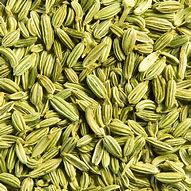
Fennel seeds
Posted February 22, 2022.

Fennel seeds
Source:
What Is Fennel? (And How to Cook It) | Cooking School | Food Network
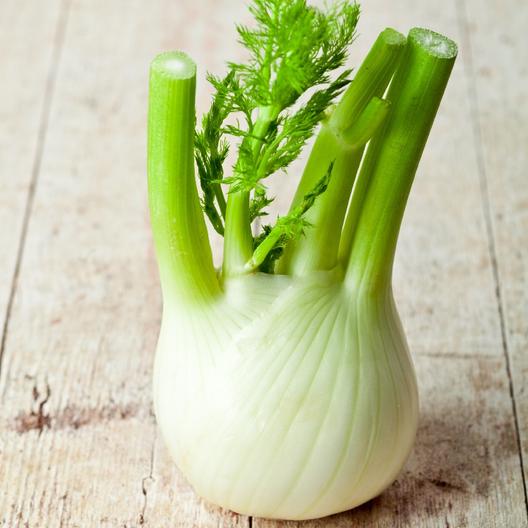
Perhaps you've seen fennel crop up in markets in late winter to early spring. Or maybe you've seen fennel seeds listed as an ingredient in Italian sausage. With its layered, bulb-like base and long fronded stalks, fennel looks intimidating and hard to cook. In reality, it's not, and you'll be hooked by its unique flavor and crisp texture. We're on a mission to spread the word on fennel, so we’ve compiled everything we think you might want to know to get started using it.
What Is Fennel?
Fennel is a layered, bulbous vegetable that originated
in the
There are two varieties of fennel. The vegetable we eat and from which fennel seeds are harvested is called Florence fennel. The other is fennel called vulgare. The yellow flowers of this variety are crushed up into the spice fennel pollen.
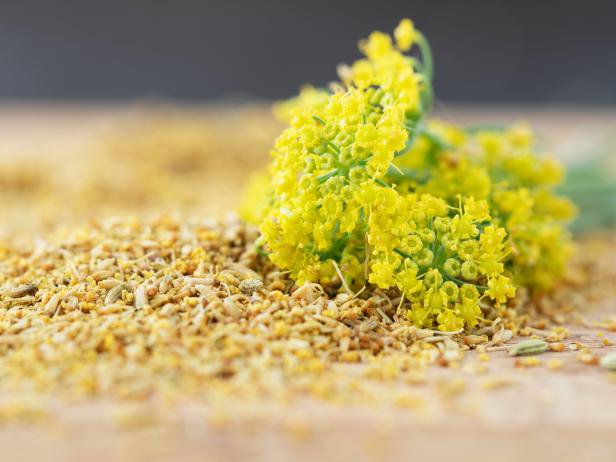
Fennel has a very mild anise or licorice flavor that can be enhanced or sweetened depending on how it is cooked (or not cooked). When diced and sauteed with onions as one of the first steps when making a soup or stew, fennel becomes very sweet. If you’re looking for a pronounced fennel flavor, try crushing or chopping a teaspoon or two of fennel seed and adding it with the diced fennel when you start your sauteed vegetables. When fennel is sliced and used in a salad, the flavor is more pronounced, brought out by the vinaigrette you use.
Surprisingly, fennel is not even closely related to
onions, as the layers are the only resemblance. In fact, fennel bulbs’ closest
relatives are carrots. Their wispy fronds look very similar to fresh dill, but
fennel isn’t related to dill either.
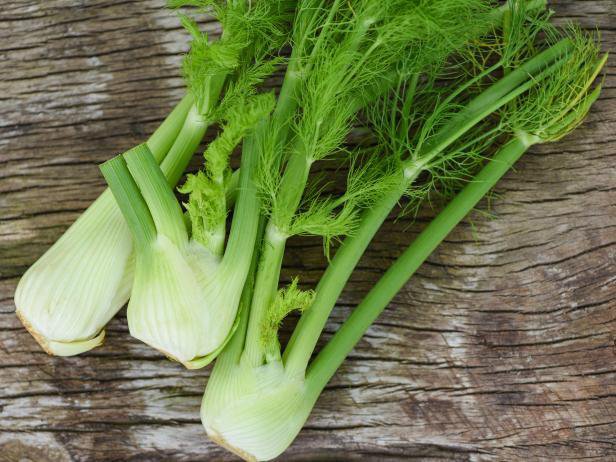
panida wijitpanya/Getty Images
We can, and do, eat all of the parts of the fennel
plant. Let’s start at the bottom:
·
Fennel roots are tuberous and can be peeled, diced and used as
carrots when cooked. They are white, so adding them to a soup you’d puree is a
flavorful way to add some bulk to create a thicker soup. Not the best choice for
eating raw.
·
The bulb is the bulk of the plant, with its thick ribbed layered
leaves, each producing a stalk. The bulb can be sliced, diced, cut in wedges or
peeled into leaves. The fennel bulb can be eaten raw or cooked.
·
The stalk is quite fibrous, and to eat it directly, it must be
cooked. Adding stalks to a broth or soup for flavor and then discarding it a
great way you can harness its flavor.
·
Fennel fronds grow out of the stalks and look like beautiful,
frilly, thread-like dill. They are a delicate garnish and are also used as a
fresh herb in salads and other dishes.
·
As fennel grows and ages, it flowers. When the flowers are
harvested and dried, they are packaged as fennel pollen, a delicacy and the
darling of chefs everywhere.
·
When not harvested as pollen, the flowers produce seeds, and
these are the fennel seeds that you buy in a jar and see in sweet Italian
sausage and finocchio salami.
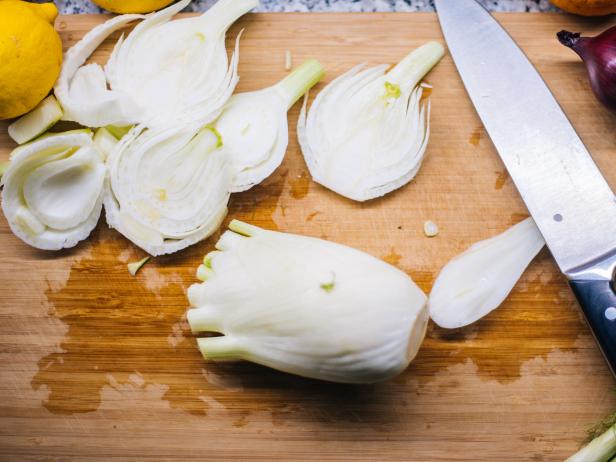
agrobacter/Getty Images
The bulb is the part of fennel you will use most
frequently. When you look for it at the market, look for the whitest, firmest
bulbs you can find, with at least three inches of stalk: the stalk keeps the
bulb layers from drying out quickly. Look at where the outer leaves attach to
the bulb: this area should not look spongy. To store, remove stalks and fronds
from bulb and wrap separately in plastic bags; keep in the refrigerator drawer
for 5 to 7 days.
1. Cut the stalks off the bulb.
2. Remove any "rusty" dark brown spots from the outer layers of the bulb with a peeler or paring knife. Many, many (almost all) recipes will tell you to peel off the outer layers. If you do this, you stand the chance of losing up to 35% of your bulb, because the two outer leaves are the biggest and heaviest.
3. Now the cutting decision has to be made, and you’ll probably do whatever the recipe says. If the bulb is to be quartered and your bulb is the size of a softball, cut it in eighths. If the recipe says sliced, you can cut across or up and down, and the core will hold the pieces together. 1/4-inch slices with the core are best for grilling. Thin slices across are best for sautéing and putting with pasta or on a pizza. If you’re adding it as an aromatic to a soup or stew, cut it in half to create two flat pieces with the core holding it all together and then dice the fennel as you would an onion. And for a salad, your best option is a mandoline. You want the fennel to be really thin so it stays light and feathery. Chefs use mandolines. It’s not cheating.
The list of what you can do with fennel is as long as
the list of what you can do with celery or carrots or onions. It’s longer than
what you can do with any of the broccoli-cauliflower family vegetables because
fennel is sweet and gentle and never offends anyone, if you know what we mean.
So put in soups and stews, pastas and salads, on pizzas
and in vegetables sandwiches with roasted peppers and onions and melty Italian
cheeses. One of our favorite ways to eat fennel is grilled. However: fennel will
dry out and get tough if you attempt to cook it 100% of the way on the grill.
Bring a large pot of salted water to a boil and blanch the fennel to cook it 50%
of the way before grilling. That way, when you grill it, you’ll be getting all
of the grill flavor and it will maintain its fennel-ness and not taste like
burnt mystery vegetable.
Making fresh fennel candy and fennel syrup are the two
most intriguing uses for fennel that we’ve seen. The stalks are thinly sliced
and cooked in a sugar syrup, then dried. The make a treat or a very cheffy
garnish for any dessert that has other licorice flavors. The leftover syrup is a
favorite of mixologists when they want the freshest sweet licorice flavor,
especially cocktails with absinthe, as fennel is one of the ingredients in
absinthe.
Celery is often mentioned as a good substitute for
fennel, and that is true if you’re using it in a salad. But celery has a fairly
assertive, nothing-like-fennel flavor when cooked, and if you don’t care for it,
too much celery can overpower everything else, and you’ll be supremely
disappointed. For a mild flavor with a similar texture, you can use the white,
thicker part of bok choy. Adding extra onion is also an option. Onion will add
sweetness, bok choy a little bite. We like to add crushed fennel seed to a
cooked dish when we use a substitute for the bulb so we do get fennel flavor.